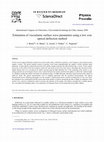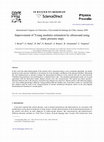Papers by GUILLERMO BALAY

Materials Letters, 2017
The elasticity response of synthetic vascular grafts is very important for the grafts long term s... more The elasticity response of synthetic vascular grafts is very important for the grafts long term success. Natural arteries possess a characteristic response to internal pressure, known as J-curve. Mimicking this feature is believed to be the path to obtain a vascular graft that does not fail over time. In this work, two synthetic bioresorbable polymers were selected to design small-diameter vascular grafts (SDVGs) based on their biomimetic mechanical response. Poly(L-lactic acid) (PLLA) was chosen for its similar response to collagen and a segmented poly(ester urethane) (PHD) was used to introduce elastomeric properties through its elastin-like behavior. A bilayered electrospun conduit with two different PLLA/PHD blends was fabricated by mimicking the natural collagen-to-elastin ratio in the media and adventitia layers. The biomimetic mechanical response, compliance and elastic modulus were studied under pulsated pressure conditions. The grafts nanofibrous morphology as well as its layered structure resulted in properties promising for bypass applications.

2014 36th Annual International Conference of the IEEE Engineering in Medicine and Biology Society, 2014
In-vivo implanted vascular grafts fail due to the mechanical mismatch between the native vessel a... more In-vivo implanted vascular grafts fail due to the mechanical mismatch between the native vessel and the implant. The biomechanical characterization of native vessels provides valuable information towards the development of synthetic grafts. Five samples of electrospun nanofibrous poly(L-lactic acid)(PLLA) tubular structures were subjected to physiological pulsating pressure using an experimental setup. Four ovine femoral arteries were also tested in the experimental setup under the same conditions. Instantaneous diameter and pressure signals were obtained using gold standard techniques, in order to estimate the dynamic pressure-strain elastic modulus (E(Pε)) of both native vessels and grafts. Synthetic grafts showed a significant increase of E(Pε) (10.57±0.97 to 17.63±2.61 10(6) dyn/cm(2)) when pressure was increased from a range of 50-90 mmHg (elastin-response range) to a range of 100-130 mmHg (collagen-response range). Furthermore, femoral arteries also exhibited a significant increase of EPε (1.66±0.30 to 15.76±4.78 10(6) dyn/cm(2)) with the same pressure variation, showing that both native vessels and synthetic grafts have a similar behavior in the collagen-acting range. The mechanical behavior of PLLA vascular grafts was characterized In vitro. However, the procedure can be easily extrapolated to In vivo experiences in conscious and chronically instrumented animals.

2011 Annual International Conference of the IEEE Engineering in Medicine and Biology Society, 2011
Simultaneous measurement of pressure and diameter in blood vessels or vascular prosthesis is of g... more Simultaneous measurement of pressure and diameter in blood vessels or vascular prosthesis is of great importance in cardiovascular research. Knowledge of diameter changes as response to intravascular pressure is the basis to estimate the biomechanical properties of blood vessel. In this work a new method to quantify arterial diameter based in high resolution ultrasonography is proposed. Measurements on an arterial phantom placed on a cardiovascular simulator were performed. The results were compared to sonomicrometry measurements considered as gold standard technique. The obtained results indicate that the new method ensure an optimal diameter quantification. This method presents two main advantages respect to sonomicrometry: is noninvasive and the vessel wall strain can be measured directly.

Physics Procedia, 2010
In this work an optical deflection method was used to study surface vibrations created by a low f... more In this work an optical deflection method was used to study surface vibrations created by a low frequency source placed on the sample's surface. The optical method consists in placing a laser beam perpendicularly the sample's surface (gelatine based phantom). A beam-splitter is placed between the laser and the sample to project the reflected beam into a screen. As the surface moves due to the action of the low frequency source the laser beam on the screen also moves. Recording this movement with a digital camera allow us to reconstruct de surface motion using the light reflection law. If the scattering of the surface is very strong (such the one in biological tissue) a lens is placed between the surface and the beam-splitter to collect the scattered light. As validation method the surface movement was measured using a 10 MHz ultrasonic transducer placed normal to the surface in pulse-eco mode. The optical measurements were in complete agreement with the acoustical measurements. The optical measurement has the following advantages over the acoustic: 2-dimensional motion could be recorded and it is low cost. Since the acquisition was synchronized and the source-laser beam distance is known, measuring the time of flight an estimation of the surface wave velocity is obtained in order to measure the elasticity of the sample. The authors conclude that a reliable optical, low cost method for obtaining surface wave parameters of biological tissue was developed and successfully validate.
2010 Annual International Conference of the IEEE Engineering in Medicine and Biology, 2010
Atherosclerotic plaque complication is a major cause of vascular accidents. Although a variety of... more Atherosclerotic plaque complication is a major cause of vascular accidents. Although a variety of factors have been proposed as key factors in these process, the mechanism that contribute to this problem remain to be characterized. Previously we demonstrated that changes in arterial wall viscous and elastic properties and/or in the filtering function (FF) could be part of the arterial wall
2010 Annual International Conference of the IEEE Engineering in Medicine and Biology, 2010
The early detection of biomechanical modifications in the arterial wall could be used as a predic... more The early detection of biomechanical modifications in the arterial wall could be used as a predictor factor for various diseases, for example hypertension or atherosclerosis. In this work a transient elastography technique is used for the in vitro evaluation of the arterial wall elasticity. The obtained Young modulus is compared with the one obtained by a more classical approach: pressure-diameter relationships. As a sample an arterial phantom made of PolyVinyl Alcohol (PVA) gel was used. Diameter variation due to pressure variation inside the phantom was recorded by means of ultrasound. Through both techniques similar Young modulus estimations are obtained showing in this way the feasibility of applying transient elastography for the arterial wall elasticity assessment.

Materials science & engineering. C, Materials for biological applications, 2014
Development of successful small-diameter vascular grafts constitutes a real challenge to biomater... more Development of successful small-diameter vascular grafts constitutes a real challenge to biomaterial engineering. In most cases these grafts fail in-vivo due to the presence of a mechanical mismatch between the native vessel and the vascular graft. Biomechanical characterization of real native vessels provides significant information for synthetic graft development. Electrospun nanofibrous vascular grafts emerge as a potential tailor made solution to this problem. PLLA-electrospun nanofibrous tubular structures were prepared and selected as model bioresorbable grafts. An experimental setup, using gold standard and high resolution ultrasound techniques, was adapted to characterize in vitro the poly(L-lactic acid) (PLLA) electrospun structures. The grafts were subjected to near physiologic pulsated pressure conditions, following the pressure-diameter loop approach and the criteria stated in the international standard for cardiovascular implants-tubular vascular prostheses. Additionall...

Journal of Physics: Conference Series, 2013
ABSTRACT Arterial behaviour in-vivo is influenced, amongst other factors, by the interaction betw... more ABSTRACT Arterial behaviour in-vivo is influenced, amongst other factors, by the interaction between blood flow and the arterial wall endothelium, and the biomechanical properties of the arterial wall. This interaction plays an important role in pathogenic mechanisms of cardiovascular diseases such as atherosclerosis and arteriosclerosis. To quantify these interactions both from biomechanical and hemodynamical standpoints, a complete characterization and modelling of the arterial wall, blood flow, shear wall and circumferential wall stresses are needed. The development of a new multi-parameter measurement system (distances, pressures, flows, velocity profiles, temperature, viscosity) for an in-vitro characterization of the biomechanics and hemodynamics in arterial bifurcations (specially in carotid bifurcations) is described. This set-up represents an improvement relative to previous set-ups developed by the group FCIEN-FMED and is presently under development. Main subsystems interactions and environment-system interactions were identified and compensated to improve system's performance. Several interesting problems related with signal acquisition using a variety of sensors and some experimental results are shown and briefly discussed. Experimental data allow construction of meshes and parameter estimation of the biomechanical properties of the arterial wall, as well as boundary conditions, all suitable to be employed in CFD and FSI numerical simulation.

Journal of Physics: Conference Series, 2013
ABSTRACT The quantification of fluid-structure interactions in arterial walls (from a biomechanic... more ABSTRACT The quantification of fluid-structure interactions in arterial walls (from a biomechanical standpoint) requires a complete characterization of blood flow, shear stress in the interface between blood and endothelium, wall elasticity and wall stresses distribution. These interactions play an important role in pathogenic mechanisms of cardiovascular diseases, such as atherosclerosis and arteriosclerosis. A specific hemodynamic work bench simulator is used for an in-vitro characterization of the biomechanics and hemodynamics of a custom constructed physical model of arterial bifurcation, under near-physiologic pulsated flow conditions. The model was constructed using fresh porcine aorta. Some experimental in-vitro results are shown. In-vitro results are compared with in-silico results obtained from a simple CFD model of the abovementioned bifurcation. Experimental data allow construction of meshes and parameter estimation of the biomechanical properties of the arterial wall, as well as boundary conditions, all suitable to be employed in CFD and FSI numerical simulation. In-silico simulations enables the estimation of some parameters that cannot be easily obtained by means of in-vitro experimental measurements (for example wall shear stress).

International Congress on Ultrasonics, Proceedings, 2010
In this work the radial displacement of the arterial wall is measured using a cross correlation a... more In this work the radial displacement of the arterial wall is measured using a cross correlation algorithm. An elastic model for static pressure conditions is developed, fit to the boundary conditions of the physical problem. Measuring the wall displacements as pressure changes the biomechanical behavior of the arterial wall can be characterized. Validation measurements were performed in a calibrated latex tube. The obtained experimental results are in good agreement with the theoretical model. Human arteries were also characterized. The typical non linear pressurediameter behavior due to the presence of elastine and collagen was observed. Human arteries with atheroma plaques were also studied presenting a different Young modulus than the healthy ones. From these results we conclude that this method could be used in the characterization of arterial mechanical alterations and/or in the post-implant biomechanical evaluation of vascular grafts.

Physics Procedia, 2010
In this work a circulating loop capable of mimicking the physiological pressure and flow conditio... more In this work a circulating loop capable of mimicking the physiological pressure and flow conditions inside a vessel is set up. The circulating loop consists of an artificial heart coupled to a perfusion line made of polyethylene and silicon. The artificial heart is driven by a pneumatic pump which provides the desired heart rate, pressure values and length of the systolic and diastolic period of each cycle. To measure the changes in diameter of the segment under study, an ultrasonic probe in pulse eco mode is used. For pressure monitoring a pressure sensor is positioned inside the sample. Pressure-diameter loops were obtained for characterization of the dynamical properties of the arterial wall. In vitro measurements were made on three different conduits: 1) Calibrated tubes made of latex: these phantoms were characterized by the presented method, 2) Non-atherosclerotic human carotid arteries obtained from donors and 3) Atherosclerotic human carotid arteries with atheroma plaques. In the three cases, under physiological simulated conditions, the mechanical properties of the conduit were obtained. We conclude that atheroma plaques were successfully detected and its dynamical properties characterized. This method could be used in the experimental and clinical field to characterize the effects of atheroma plaques on the arterial wall biomechanics.
Conference proceedings : ... Annual International Conference of the IEEE Engineering in Medicine and Biology Society. IEEE Engineering in Medicine and Biology Society. Annual Conference, 2013
To quantify fluid-structure interactions in arterial walls, from a biomechanical standpoint, a co... more To quantify fluid-structure interactions in arterial walls, from a biomechanical standpoint, a complete characterization of blood flow, shear stress in the interface between blood and endothelium, wall elasticity and wall stresses distribution are needed.

Conference proceedings : ... Annual International Conference of the IEEE Engineering in Medicine and Biology Society. IEEE Engineering in Medicine and Biology Society. Annual Conference, 2010
In several clinical and experimental circumstances, it is widely necessary to characterize the bi... more In several clinical and experimental circumstances, it is widely necessary to characterize the bio-mechanical changes induced by atherosclerosis to the arterial wall. In this context, the purpose of this paper is twofold. Firstly, to propose a low cost ultrasound setup to improve artery radii determination in elasticity experiments, based on two transducers using a single channel ultrasound hardware. Secondly, to present an in vitro artificial heart system developed in our laboratory, which provides a wide range of hemodynamic parameters in arterial elasticity assessment experiments. It can be used in a liquid, stand alone mode or blowing air to a Jarvik device. This system will be integrated in future works with the proposed ultrasound setup to provide real time elasticity measurements.








Uploads
Papers by GUILLERMO BALAY